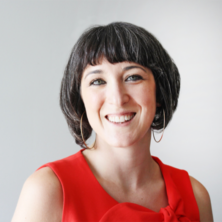Perspectives
Lisa Stern’s Story
Lisa is a clinician and educator who has worked to replace mainstream public health lessons in her background with user-centered engagement and an equity lens. Her story describes developing an understanding of race, class and gender early on in her Jewish day school and public high school experiences, which CoreAlign helped to reawaken and to sharpen.
I can remember the times in my young life where injustices were made plain to me, most of those having to do with gender. I went to a Jewish day school for kindergarten through eighth grade and I had experiences where things were overtly denied to me because I was a girl. Some of those were religious, like certain prayers I couldn’t say or services I couldn’t lead, but then some of those were also secular. And that seemed really questionable to me. But I was also lucky to come of age at a time where there was a lot of change happening in the Jewish world around what girls and women were allowed to do. And I got to be very active in my own synagogue. I got to be the first girl to do a lot of things in my community, to push for things from an intellectual standpoint as well as a moral standpoint. The support AND opposition that I got from grown men shaped me.
I went directly from this tiny school to a very large public high school, and it was the first time in my life where racial difference was apparent to me on a daily basis. The school was less than 50% white, and it was a deep privilege to both be in such a diverse setting and get to think deeply and critically about race as a very young person. The discrimination was blatant to me. I started asking, why is there one black person, the same black person, the only black person in all of my honors and AP classes with all these other black kids in the school? And I think because of my own experience, it was just obvious to me that it wasn’t natural, that it had to be the result of systemic oppression. As a white person and as someone who didn’t grow up around a lot of people of color, it ignited a lot of curiosity for me about race and how it functioned in my community and then how it functioned more broadly.
Another element in my high school was that there were a lot of pregnancies, and that also was very racialized. I knew maybe one white person who got pregnant in high school and I knew many black people who were pregnant. I think I had a very mainstream understanding of that dynamic. I had the stigmatizing idea that: “Teen pregnancy is a problem which disproportionately affects black girls, and that problem needs to be fixed…” A very profound shift for me in my adult thinking about social change has been finding a way to still care about reproductive health and people being able to become pregnant when, how and if they want to — but not characterizing something like teen pregnancy as a problem to be fixed.
I went to nursing school, which I loved. But I think that’s also where I relearned a lot of those problematic public health ideas that I had picked up in high school. Then when I went to work as a clinician, I had to confront them again. CoreAlign has been very important for me in walking me from that 17, 18 year old self to developing a more sophisticated lens on social problems and on racism. It helped me go from being a run of the mill, semi-problematic clinician to digging myself back out of that. There’s all sorts of coercion and violence in exam rooms; it’s not because those clinicians are bad people. Well, some are bad people for sure. But by and large, it’s because we’re products of pretty bad training in a pretty problematic society. And so there’s a lot we have to do to counteract that as a culture and as professionals, but also as individuals too. If we’re going to be different, that takes a lot of collective, conscious, hard work.
And I think this goes back to the fixing mentality, and the shift for me: you can’t solve any problem without centering the people impacted. Having access to concrete techniques at CoreAlign, especially around end-user engagement, has changed the way I approach my work. In many places I have worked, everyone wanted to talk about and pat themselves on the back for being “patient-centered” without defining what that meant or having a specific way to carry it out. Having the design thinking mentality and the techniques to be able to say, well, if something’s patient-centered, that definitely means that there needs to be authentic end-user engagement. If you’re not deeply engaging with and getting feedback from the end-user, that’s a problem.
